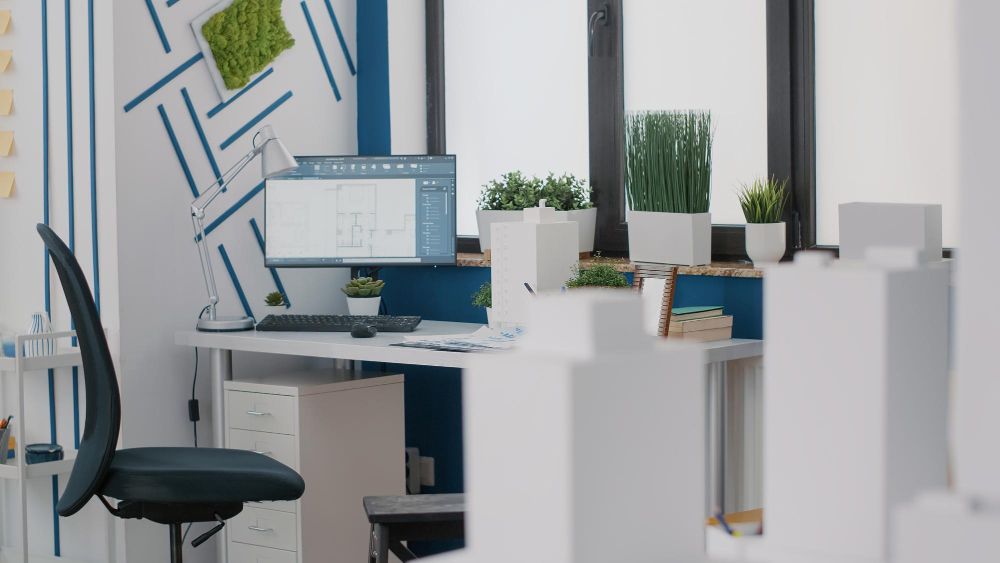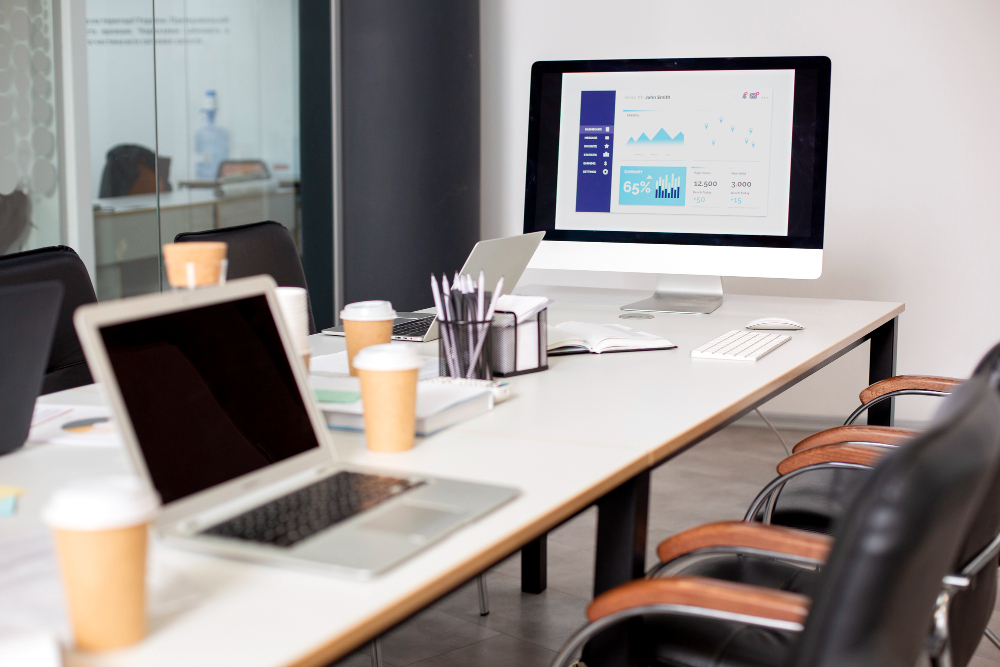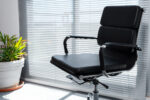
What is a Workstation?
In the modern work environment, the term “workstation” is often used interchangeably with terms such as desk, office table, or cubicle. But what is a workstation, really?
Is it just another fancy term for a desk? Or does it represent something more thoughtfully designed and functionally different? The answer lies in how we understand and apply the concept in today’s office settings.
What Are Workstations? A Dual-Purpose Definition
When asking, “What are workstations?” you’ll find the answer depends on context. The term has two primary interpretations.
Technically, it may refer to a high-powered computer designed explicitly for data-intensive tasks such as video rendering, scientific modeling, or software development.
These computing workstations are known for their robust processors, memory capacity, and advanced graphics capabilities.
However, in the context of office furniture and interior layout, the term takes on a different, more spatial meaning.
Here, a workstation refers to a designated work area, typically tailored to the individual’s needs or the specific type of task at hand.
It includes not just a desk or table but the accompanying ergonomic chair, storage units, partitions, lighting, and sometimes even personalized tools that enhance productivity.
In essence, a workstation in an office context is a well-equipped, often modular workspace that enables employees to perform specific tasks efficiently and comfortably.
Workstations in the Office: More than just Furniture

Traditional office setups focused on uniformity, with identical desks placed side by side with little regard for individual comfort.
However, office workstation layouts have evolved to accommodate these changes. Now, every workstation is seen as a micro-environment. It’s not just where you sit but how you work best.
In an open office floor plan, you’ll find modular workstations configured in clusters or rows designed to save space while allowing each employee to personalize their area.
These often feature compact desks with enough room for a laptop, a monitor riser, and sometimes a small storage unit tucked underneath. Ergonomic chairs with adjustable heights and breathable mesh backs are almost standard.
What differentiates these spaces from ordinary desks is the intent behind the setup. Everything is carefully selected and arranged to minimize strain, optimize workflow, and promote good posture over extended periods of time.
Workstation for Office Use: More than just a Table and Chair
The traditional office setup typically featured basic desks and chairs arranged in rows or within cabins.
But as modern work culture evolved, so did the need for spaces that are both functional and flexible. The workstation for office use has become a thoughtful blend of design, practicality, and individual customization.
Unlike generic desks, workstation office setups are typically modular and ergonomic. They are configured for the type of work being performed.
For example, a data entry operator’s workstation may include a compact desk, monitor stand, wrist support, and under-desk footrest.
In contrast, a creative professional may require a larger L-shaped workstation that accommodates dual monitors, sketch pads, or additional accessories such as ring lights and vision boards.
What sets workstations apart is that they are designed to optimize space and enhance focus. They’re often found in open-plan offices where personal space is limited, but productivity still needs to be maximized.
Furniture that Defines a Workstation
When discussing what a workstation is, you can’t ignore the furniture elements that make it up. It’s not just about having a desk and a chair.
A complete workstation incorporates functional design features and smart furniture choices that can be adjusted to meet the needs of the worker.
A standard workstation might include a compact, modular desk that fits easily into small spaces without compromising on work surface area. Many affordable solutions include foldable or wall-mounted desks that save space while still providing utility.
The desk is often paired with an ergonomic office chair, ideally one with lumbar support, adjustable height, and swivel capability.
These are vital for long hours at the desk and are now available even in budget-friendly ranges without compromising on comfort.
Additionally, low-cost under-desk storage units or sliding drawer organizers help keep the area clutter-free.
Add-ons like monitor risers, cable trays, and even a small movable side table contribute to better posture and organization.
If budget is a concern, you can always reach out for Cheaper Office Solutions’ affordable office furniture, which includes ready-to-assemble workstation kits or minimalist desk-and-chair combos that don’t break the bank yet still offer comfort and durability.
These can often be customized with affordable accessories, such as portable footrests, clip-on task lighting, or felt pin boards for notes.
Personalization and Ergonomics: The Core of a Workstation
Another defining trait of workstations is their adaptability to the user’s needs. Unlike a generic desk setup, a workstation is adjustable.
The height of the chair and desk, the angle of the screen, and the placement of accessories can all be tailored to ensure optimal comfort and posture.
This focus on ergonomics not only improves productivity but also visibly lowers the risk of chronic pain or repetitive strain injuries, especially for people who spend long hours seated.
For instance, if your job requires extensive typing, your workstation might feature a keyboard tray, wrist pad, and a chair with forearm support.
Meanwhile, someone focused on reading or research might prioritize a desk lamp, a bookshelf, and a larger working surface. Over time, these adjustments contribute to a healthier and more sustainable work environment.
Aesthetics in Workstations: Function Meets Style
While functionality is paramount, aesthetics in workstations shouldn’t be overlooked. A workspace that looks good often makes you feel good and more motivated. So, what do aesthetically pleasing workstations look like?
They balance color, texture, and form. Clean lines, natural wood finishes, soft lighting, and minimalist setups are now trending.
Even in small spaces, adding decorative elements like small indoor plants, framed motivational quotes, good lighting, or smart storage bins can elevate the overall vibe of your workstation.
Color also plays an important role. Lighter tones, such as white, ash grey, or soft oak, help reflect light and create an airy, focused feel.
Matte black or deep blue elements can add contrast and depth. Most affordable office solutions are also available in a broad range of colors and finishes, allowing individuals or companies to maintain their brand aesthetic without incurring expensive customization costs.
Open Plan vs Cubicle: How Workstations Fit Different Office Types
Modern offices typically fall into two categories: open-plan layouts and segmented cubicles. In both formats, the definition of workstation remains relevant, but its execution changes.
In open-plan offices, workstations are often modular setups with low or no partitions. The furniture is typically minimalist and space-efficient, making it easy to rearrange or scale up as the team expands.
Here, lightweight mobile desks, ergonomic mesh chairs, and shared storage areas are standard components.
In cubicle-style offices, each workstation often features higher partitions for privacy, and furniture choices tend to lean toward sturdier, more permanent setups.
However, even these can be optimized with cost-effective ergonomic furniture and clever design hacks, such as wall-mounted organizers and under-desk filing cabinets.
Why Does the Right Workstation Matters?
Workstations are not just about sitting down and getting the job done; they are also about productivity and efficiency.
They’re about creating an environment where productivity flows effortlessly. When someone asks, “What is a workstation?” The answer is more nuanced than “a desk with a chair.”
It’s a carefully constructed space where comfort meets function, where design enhances focus, and where personalization drives performance.
Workstations Across Different Office Layouts
The definition of a workstation may shift slightly depending on the office layout. In open offices, the setup is lightweight, flexible, and modular.
There’s more collaboration but less privacy. In cubicle environments, partitions provide each workstation with its own “room,” which may require slightly more robust furniture.
Even in co-working spaces, where desks are shared and constantly rotated, workstations are often temporarily customized.
One person might move in for a day with a laptop stand, mouse pad, and personal coffee mug and still recreate a focused, personalized workspace.
Every variation proves one thing: a workstation isn’t just about the physical desk or chair. It’s about the experience of working well.
Emotional Value: How a Workstation Affects How We Work
A workstation does more than hold your computer and paperwork. It affects your energy, mood, and mindset.
A thoughtfully designed space can reduce overwhelm, minimize distractions, and help you move through the day with purpose.
When your chair supports you, your monitor is at eye level, and your workspace is clean and inspiring, you begin to notice the difference. You’re not just more productive; you’re more present, more creative, and less stressed.
That’s why investing in even a simple, low-cost workstation setup can be transformative. Whether it’s a DIY solution with second-hand furniture or a fully furnished modular layout, what matters is the intentionality behind the space.
Having a well-thought-out workstation improves efficiency, boosts morale, and promotes physical well-being.
Whether you’re equipping a home office or setting up a collaborative workspace, investing in the right furniture without overspending can make all the difference.
Final Thoughts: Elevating Work through Smart Design
To sum it up, workstation office environments are no longer confined to dull, uniform cubicles. They’re smart, stylish, and often surprisingly affordable.
Whether you opt for modular desks, budget-friendly ergonomic chairs, or comprehensive workstation kits, the idea remains the same: create a personalized, compact, and efficient workspace tailored to your specific work needs.
If you’re planning your own office layout or revamping your current setup, understanding the true definition of the workstation is key to creating an environment that fosters creativity, comfort, and productivity.
Need help building the ideal office workstation? Reach out to Cheaper Office Solutions; we can help you find cost-effective, space-saving, and beautifully designed workstations that reflect both your brand and your team’s needs. Because a workstation isn’t just a place to work; it’s a place to thrive.

 17014 S. Vermont Ave #C, Gardena, CA 90247
17014 S. Vermont Ave #C, Gardena, CA 90247 (310) 856-3456
(310) 856-3456



